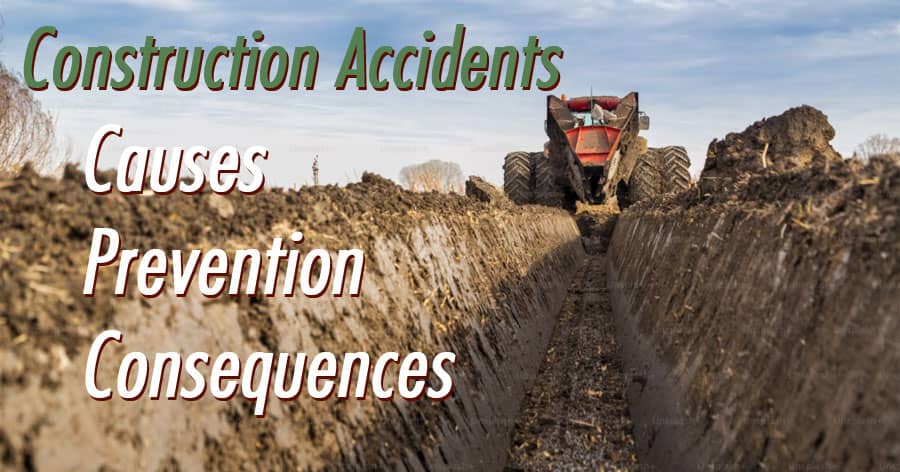Construction Accidents: Causes, Prevention, and Consequences

Introduction
Construction accidents can have severe consequences, leading to injuries, fatalities, and significant financial and emotional burdens. Safety is of paramount importance in the construction industry, and understanding the causes, implementing preventive measures, and promoting a culture of safety are vital for ensuring the well-being of workers and the success of construction projects.
Common Causes of Construction Accidents
Several factors contribute to construction accidents:
- Lack of proper training and supervision: Insufficient training on safety protocols and lack of adequate supervision can increase the risk of accidents on construction sites.
- Hazardous working conditions: Exposing workers to hazardous substances, unsafe scaffolding, inadequate fall protection, or insufficient lighting can lead to accidents.
- Negligence and human error: Inattentiveness, carelessness, and failure to follow safety procedures can result in accidents that endanger both the worker and others on the site.
- Equipment malfunction or failure: Faulty machinery, equipment malfunctions, or improper maintenance can cause accidents, such as collapses, electrical shocks, or equipment-related injuries.
- Falls from heights: Working at elevated heights without proper fall protection measures in place poses a significant risk, resulting in severe injuries or fatalities.
- Electrocution: Coming into contact with live wires, faulty electrical equipment, or improper grounding can lead to electrocution accidents.
- Struck-by accidents: Workers may be struck by falling objects, moving vehicles, or heavy equipment due to poor site organization or inadequate communication.
- Caught-in or between accidents: Workers can become caught in or between machinery, equipment, or collapsing structures, resulting in serious injuries or fatalities.
Preventing Construction Accidents
Prevention is key to minimizing construction accidents. Here are some effective preventive measures:
- Implementing comprehensive safety programs: Construction companies should establish robust safety programs that include risk assessments, safety policies, and procedures tailored to the specific tasks and hazards present on their worksites.
- Conducting regular safety training and education: Ongoing training and education programs should be provided to all workers, emphasizing hazard recognition, safe work practices, and the proper use of personal protective equipment (PPE).
- Providing appropriate personal protective equipment (PPE): Employers must ensure that workers have access to and use the necessary PPE, such as hard hats, safety goggles, gloves, and high-visibility clothing, to minimize the risk of injuries.
- Conducting thorough inspections and maintenance of equipment: Regular inspections and maintenance of machinery, tools, and equipment are crucial to identify potential hazards or defects and ensure they are promptly addressed.
- Enforcing safety regulations and guidelines: Employers must enforce strict adherence to safety regulations and guidelines set by local authorities and industry standards.
- Promoting a culture of safety and accountability: Establishing a culture where safety is prioritized at all levels, and workers are encouraged to report potential hazards or near-miss incidents fosters a proactive approach to safety.

Consequences of Construction Accidents
Construction accidents can have far-reaching consequences:
- Physical injuries and fatalities: Workers may suffer severe injuries, such as fractures, amputations, traumatic brain injuries, or spinal cord injuries. In worst cases, accidents can result in fatalities.
- Emotional and psychological impact on workers: Accidents can cause emotional trauma, post-traumatic stress disorder (PTSD), anxiety, and depression among workers who witness or experience accidents.
- Financial losses for both workers and employers: Medical expenses, loss of wages, and rehabilitation costs can place a significant financial burden on injured workers and their families. Employers may face increased insurance premiums, legal expenses, and potential lawsuits.
- Legal consequences and liabilities: Construction companies may face legal liabilities, fines, and penalties if found responsible for neglecting safety regulations or failing to provide a safe working environment.
The Role of Insurance and Compensation
In the event of a construction accident, insurance and compensation play crucial roles:
- Workers' compensation insurance: Workers' compensation provides medical benefits and wage replacement for injured workers. It helps cover medical expenses, rehabilitation costs, and a portion of lost wages.
- Employer liability insurance: Employer liability insurance protects companies from financial losses and legal liabilities resulting from workplace accidents and injuries. It covers legal fees, settlements, and judgments.
- Seeking legal assistance for fair compensation: In cases of severe injuries or wrongful death, injured workers or their families may consult with experienced attorneys to ensure they receive fair compensation for their losses.
Promoting Safety and Awareness
To create safer construction environments, it's essential to promote safety and awareness continuously:
- Engaging in ongoing safety training and education: Regularly providing safety training and education helps reinforce best practices, raises awareness of potential hazards, and ensures workers stay updated on safety protocols.
- Reporting potential hazards and near-miss incidents: Encouraging workers to report potential hazards and near-miss incidents fosters a proactive safety culture and enables timely corrective actions.
- Encouraging open communication and collaboration: Open communication channels between workers, supervisors, and management promote collaboration in identifying safety improvements and addressing concerns.
- Emphasizing the importance of safety at all levels: When safety is emphasized from the top-down, and all employees are held accountable for their actions, it creates a collective commitment to maintaining a safe work environment.
Conclusion
Construction accidents can have devastating consequences, but they are preventable. By addressing the common causes, implementing effective preventive measures, and promoting a culture of safety and accountability, the construction industry can significantly reduce the risk of accidents, protect workers' well-being, and ensure successful project outcomes. Prioritizing safety should always be a top priority to create a safer and more productive construction industry.
FAQs
Can construction accidents be completely eliminated?
While it may not be possible to eliminate all construction accidents entirely, implementing comprehensive safety programs, ongoing training, and strict adherence to safety regulations can significantly reduce the risk of accidents.
What should I do if I witness a construction accident?
If you witness a construction accident, immediately report it to the appropriate authorities or supervisors. Prompt reporting allows for swift response and medical attention for the injured worker.
Who is responsible for ensuring construction site safety?
Ultimately, it is the responsibility of the employers and contractors to ensure construction site safety. They must provide a safe working environment, adequate training, proper equipment, and enforce safety regulations.
Are construction accidents more common in certain types of construction projects?
Construction accidents can occur in various types of projects, but some high-risk activities, such as working at heights or with heavy machinery, may have a higher incidence of accidents. It is crucial to implement specific safety measures for these activities.
How can workers protect themselves from construction accidents?
Workers can protect themselves by following safety guidelines, wearing appropriate PPE, participating in safety training, and reporting hazards or unsafe conditions to supervisors. It is essential to be vigilant and prioritize personal safety.
